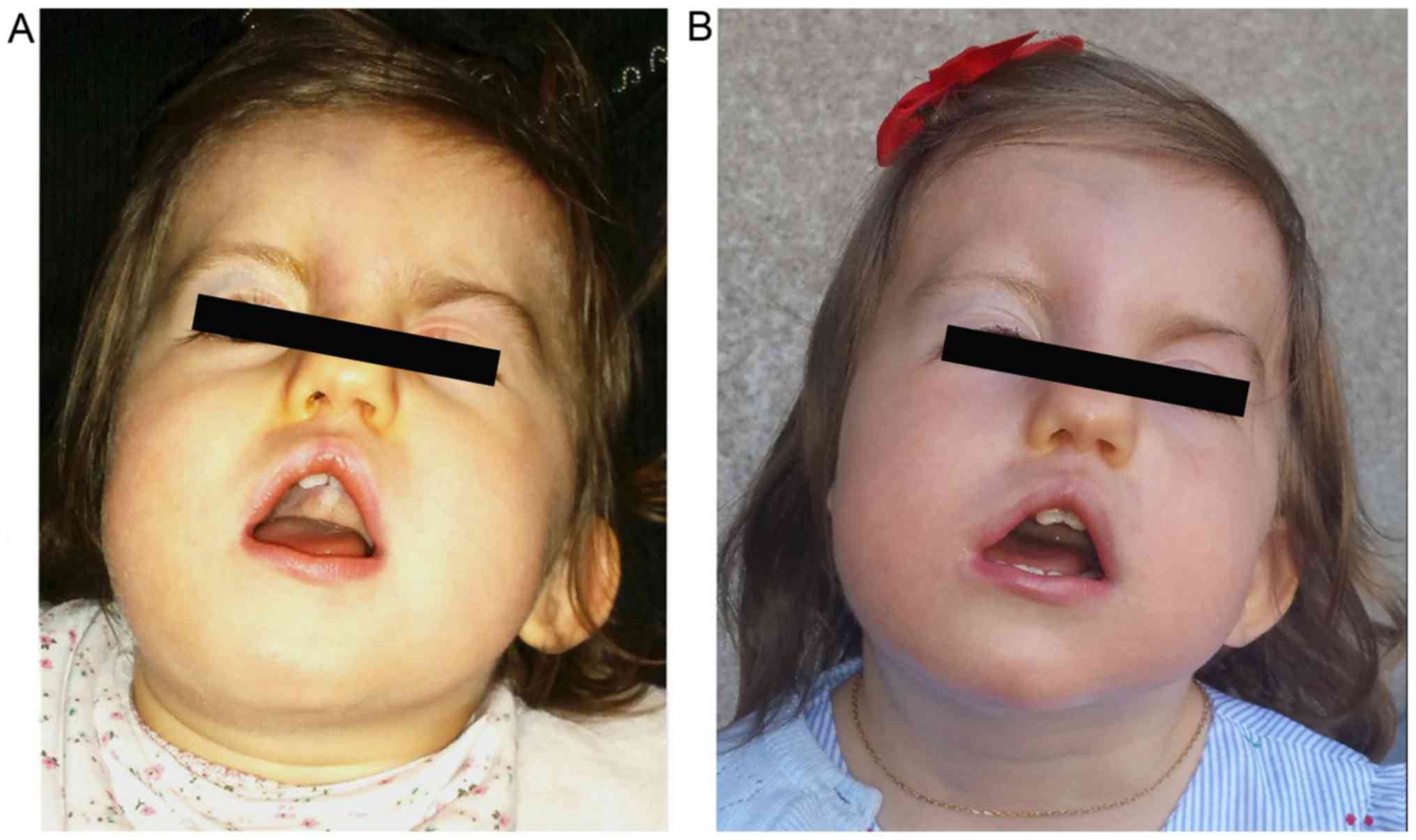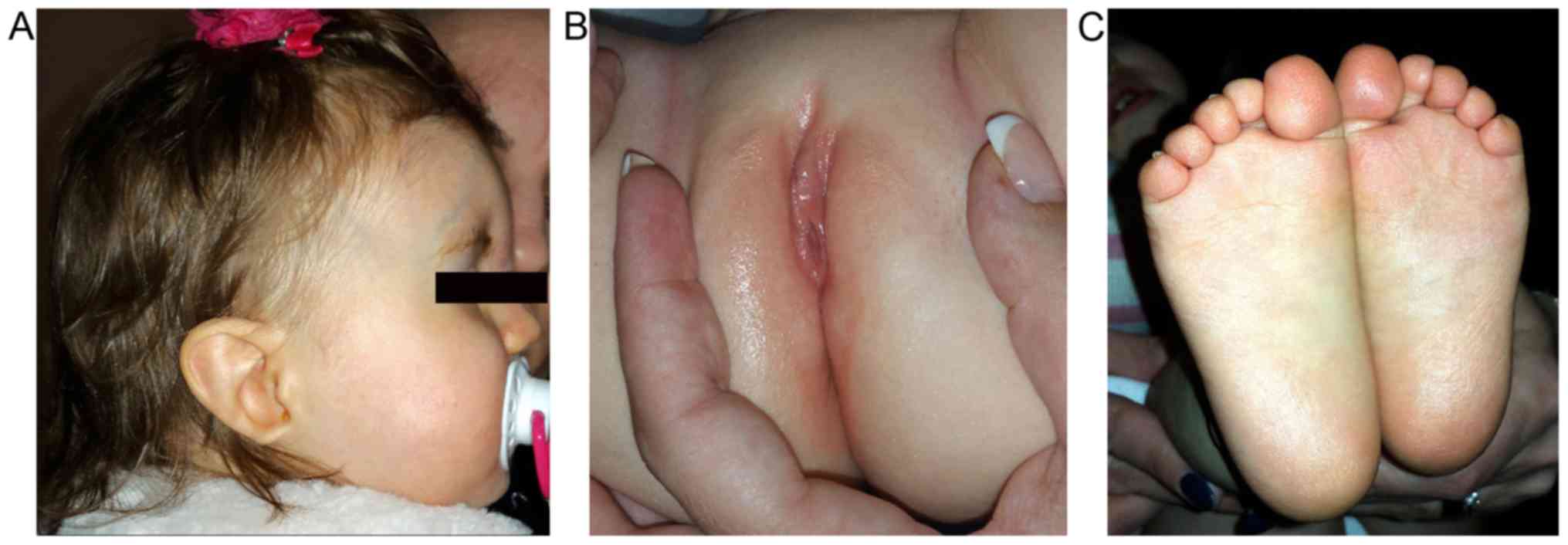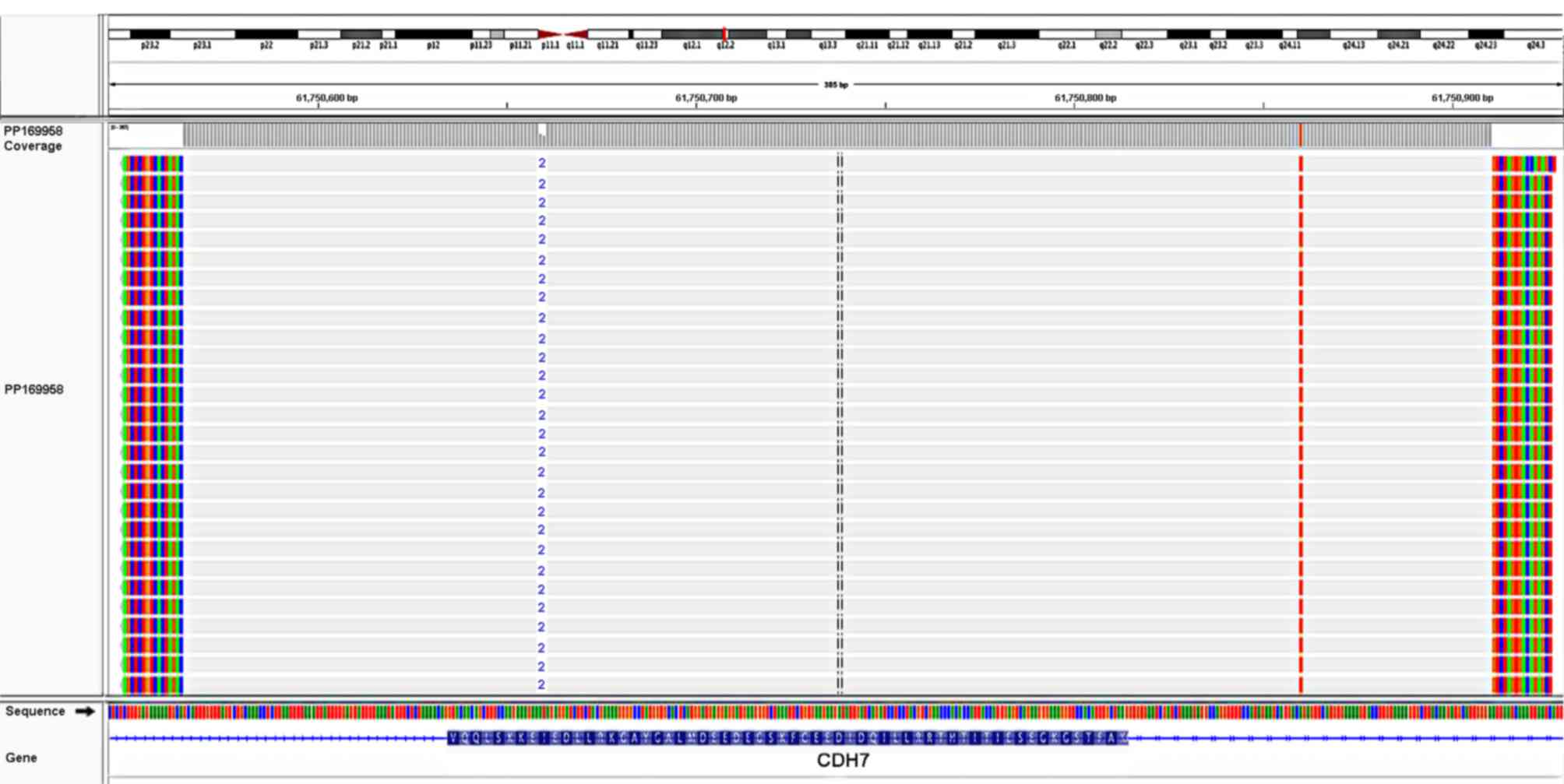|
1
|
Pagon RA, Graham JM Jr, Zonana J and Yong
SL: Coloboma, congenital heart disease, and choanal atresia with
multiple anomalies: CHARGE association. J Pediatr. 99:223–227.
1981.PubMed/NCBI View Article : Google Scholar
|
|
2
|
Basson MA and van Ravenswaaij-Arts C:
Functional insights into chromatin remodelling from studies on
CHARGE syndrome. Trends Genet. 31:600–611. 2015.PubMed/NCBI View Article : Google Scholar
|
|
3
|
Hsu P, Ma A, Wilson M, Williams G, Curotta
J, Munns CF and Mehr S: CHARGE syndrome: A review. J Paediatr Child
Health. 50:504–511. 2014.PubMed/NCBI View Article : Google Scholar
|
|
4
|
Sanlaville D and Verloes A: CHARGE
syndrome: An update. Eur J Hum Genet. 15:389–399. 2007.PubMed/NCBI View Article : Google Scholar
|
|
5
|
Blake KD and Prasad C: CHARGE syndrome.
Orphanet J Rare Dis. 1(34)2006.PubMed/NCBI View Article : Google Scholar
|
|
6
|
Trider CL, Arra-Robar A, van
Ravenswaaij-Arts C and Blake K: Developing a CHARGE syndrome
checklist: Health supervision across the lifespan (from head to
toe). Am J Med Genet A. 173:684–691. 2017.PubMed/NCBI View Article : Google Scholar
|
|
7
|
Hale CL, Niederriter AN, Green GE and
Martin DM: Atypical phenotypes associated with pathogenic CHD7
variants and a proposal for broadening CHARGE syndrome clinical
diagnostic criteria. Am J Med Genet A. 170A:344–354.
2016.PubMed/NCBI View Article : Google Scholar
|
|
8
|
Legendre M, Abadie V, Attié-Bitach T,
Philip N, Busa T, Bonneau D, Colin E, Dollfus H, Lacombe D, Toutain
A, et al: Phenotype and genotype analysis of a French cohort of 119
patients with CHARGE syndrome. Am J Med Genet C Semin Med Genet.
175:417–430. 2017.PubMed/NCBI View Article : Google Scholar
|
|
9
|
Pranckėnienė L, Preikšaitienė E, Gueneau
L, Reymond A and Kučinskas V: De novo duplication in the
CHD7 gene associated with severe CHARGE syndrome. Genomics
Insights. 12(1178631019839010)2019.PubMed/NCBI View Article : Google Scholar
|
|
10
|
Katoh-Fukui Y, Yatsuga S, Shima H, Hattori
A, Nakamura A, Okamura K, Yanagi K, Iso M, Kaname T, Matsubara Y,
et al: An unclassified variant of CHD7 activates a cryptic splice
site in a patient with CHARGE syndrome. Hum Genome Var.
5(18006)2018.PubMed/NCBI View Article : Google Scholar
|
|
11
|
Miller SA, Dykes DD and Polesky HF: A
simple salting out procedure for extracting DNA from human
nucleated cells. Nucleic Acids Res. 16(1215)1988.PubMed/NCBI View Article : Google Scholar
|
|
12
|
https://www.ncbi.nlm.nih.gov/assembly/GCF_000001405.13/-.
Accessed in July 15, 2019.
|
|
13
|
Richards S, Aziz N, Bale S, Bick D, Das S,
Gastier-Foster J, Grody WW, Hegde M, Lyon E, Spector E, et al: ACMG
Laboratory Quality Assurance Committee: Standards and guidelines
for the interpretation of sequence variants: A joint consensus
recommendation of the American College of Medical Genetics and
Genomics and the Association for Molecular Pathology. Genet Med.
17:405–424. 2015.PubMed/NCBI View Article : Google Scholar
|
|
14
|
Boia M, Iacob D, Manea A, Budișan C,
Enătescu I, Dima M and Costescu O: Creșterea şi dezvoltarea
postnatală. In: Noțiuni Practice de Puericultură. Babeş V (ed).
Timisoara. pp32–43. 2019.(In Romanian).
|
|
15
|
Delahaye A, Sznajer Y, Lyonnet S,
Elmaleh-Bergès M, Delpierre I, Audollent S, Wiener-Vacher S,
Mansbach AL, Amiel J, Baumann C, et al: Familial CHARGE syndrome
because of CHD7 mutation: Clinical intra- and interfamilial
variability. Clin Genet. 72:112–121. 2007.PubMed/NCBI View Article : Google Scholar
|
|
16
|
Hudson A, Trider CL and Blake K: CHARGE
Syndrome. Pediatr Rev. 38:56–59. 2017.PubMed/NCBI View Article : Google Scholar
|
|
17
|
Pierpont ME, Brueckner M, Chung WK, Garg
V, Lacro RV, McGuire AL, Mital S, Priest JR, Pu WT, Roberts A, et
al: American Heart Association Council on Cardiovascular Disease in
the Young; Council on Cardiovascular and Stroke Nursing; and
Council on Genomic and Precision Medicine: Genetic basis for
congenital heart disease: Revisited: A scientific statement from
the American Heart Association. Circulation. 138:e653–e711.
2018.PubMed/NCBI View Article : Google Scholar
|
|
18
|
Corsten-Janssen N, van Ravenswaaij-Arts
CMA and Kapusta L: Congenital arch vessel anomalies in CHARGE
syndrome: A frequent feature with risk for co-morbidity. Int J
Cardiol Heart Vasc. 12:21–25. 2016.PubMed/NCBI View Article : Google Scholar
|
|
19
|
Roider L, Abdelaziz A and Gaballah AH:
CHARGE syndrome with high bifurcation of the abdominal aorta and a
horseshoe kidney: A case report. J Vasc Interv Radiol.
29:1288–1290.e1. 2018.PubMed/NCBI View Article : Google Scholar
|
|
20
|
Velea PI, Mogoi M, Dema A, David V, Gug C
and Paul C: Mixed gonadal dysgenesis associated with short stature
and gonadoblastoma. Case Rep Acta Endo Buc. 11:221–227. 2015.
|
|
21
|
https://www.ncbi.nlm.nih.gov/medgen/376558.
Accessed in March 5, 2020.
|
|
22
|
Cevei M, Cssepento C, Gasparik AI and
Stoicanescu D: Utility of risk factors in the current diagnosis of
osteoporosis. Osteoporos Int. 26(184)2015.
|
|
23
|
Salem-Hartshorne N and Jacob S: Adaptive
behavior in children with CHARGE syndrome. Am J Med Genet A.
133A:262–267. 2005.PubMed/NCBI View Article : Google Scholar
|
|
24
|
https://www.ncbi.nlm.nih.gov/medgen/?term=75567-.
Accessed in July 5, 2019.
|
|
25
|
Corsten-Janssen N, Kerstjens-Frederikse
WS, du Marchie Sarvaas GJ, Baardman ME, Bakker MK, Bergman JE, Hove
HD, Heimdal KR, Rustad CF, Hennekam RC, et al: The cardiac
phenotype in patients with a CHD7 mutation. Circ Cardiovasc Genet.
6:248–254. 2013.PubMed/NCBI View Article : Google Scholar
|
|
26
|
Bergman JE, Janssen N, van der Sloot AM,
de Walle HE, Schoots J, Rendtorff ND, Tranebjaerg L, Hoefsloot LH,
van Ravenswaaij-Arts CM and Hofstra RM: A novel classification
system to predict the pathogenic effects of CHD7 missense variants
in CHARGE syndrome. Hum Mutat. 33:1251–1260. 2012.PubMed/NCBI View Article : Google Scholar
|
|
27
|
Zentner GE, Layman WS, Martin DM and
Scacheri PC: Molecular and phenotypic aspects of CHD7 mutation in
CHARGE syndrome. Am J Med Genet A. 152A:674–686. 2010.PubMed/NCBI View Article : Google Scholar
|
|
28
|
Janssen N, Bergman JE, Swertz MA,
Tranebjaerg L, Lodahl M, Schoots J, Hofstra RM, van
Ravenswaaij-Arts CM and Hoefsloot LH: Mutation update on the CHD7
gene involved in CHARGE syndrome. Hum Mutat. 33:1149–1160.
2012.PubMed/NCBI View Article : Google Scholar
|
|
29
|
Gug C, Mihaescu A and Mozos I: Two
mutations in the thiazide-sensitive NaCl co-transporter gene in a
Romanian Gitelman syndrome patient: Case report. Ther Clin Risk
Manag. 14:149–155. 2018.PubMed/NCBI View Article : Google Scholar
|
|
30
|
Gug C, Caba L, Mozos I, Stoian D, Atasie
D, Gug M and Gorduza EV: Rare splicing mutation in COL1A1 gene
identified by whole exomes sequencing in a patient with
osteogenesis imperfecta type I followed by prenatal diagnosis: A
case report and review of the literature. Gene. 741(144565): Epub
ahead of print. 2020.PubMed/NCBI View Article : Google Scholar
|
|
31
|
Pauli S, Pieper L, Häberle J, Grzmil P,
Burfeind P, Steckel M, Lenz U and Michelmann HW: Proven germline
mosaicism in a father of two children with CHARGE syndrome. Clin
Genet. 75:473–479. 2009.PubMed/NCBI View Article : Google Scholar
|
|
32
|
Gug C, Huțanu D, Vaida M, Doroş G, Popa C,
Stroescu R, Furău G, Furău C, Grigoriță L and Mozos I: De
novo unbalanced translocation t(15;22)(q26.2;q12) with
velo-cardio-facial syndrome: A case report and review of the
literature. Exp Ther Med. 16:3589–3595. 2018.PubMed/NCBI View Article : Google Scholar
|
|
33
|
Jongmans MC, Admiraal RJ, van der Donk KP,
Vissers LE, Baas AF, Kapusta L, van Hagen JM, Donnai D, de Ravel
TJ, Veltman JA, et al: CHARGE syndrome: The phenotypic spectrum of
mutations in the CHD7 gene. J Med Genet. 43:306–314.
2006.PubMed/NCBI View Article : Google Scholar
|
|
34
|
Martínez-Quintana E, Rodríguez-González F,
Garay-Sánchez P and Tugores A: Novel frameshift CHD7 mutation
related to CHARGE syndrome. Mol Syndromol. 5:36–40. 2014.PubMed/NCBI View Article : Google Scholar
|
|
35
|
Xu YP, Shi LP and Zhu J: Atypical CHARGE
associated with a novel frameshift mutation of CHD7 in a Chinese
neonatal patient. BMC Pediatr. 18(203)2018.PubMed/NCBI View Article : Google Scholar
|
|
36
|
Boer MC, Musat G and Budisteanu M: CHARGE
syndrome – a rare cause of nose and ear anomalies. A case report.
Rom J Rhinol. 3:45–48. 2013.
|
|
37
|
Marcos S, Sarfati J, Leroy C, Fouveaut C,
Parent P, Metz C, Wolczynski S, Gérard M, Bieth E, Kurtz F, et al:
The prevalence of CHD7 missense versus truncating mutations is
higher in patients with Kallmann syndrome than in typical CHARGE
patients. J Clin Endocrinol Metab. 99:E2138–2143. 2014.PubMed/NCBI View Article : Google Scholar
|
|
38
|
Kohmoto T, Shono M, Naruto T, Watanabe M,
Suga K, Nakagawa R, Kagami S, Masuda K and Imoto I: A novel
frameshift mutation of CHD7 in a Japanese patient with CHARGE
syndrome. Hum Genome Var. 3(16004)2016.PubMed/NCBI View Article : Google Scholar
|
|
39
|
Jurca A, Kinga K, Bembea M, Gug C and
Jurca C: Fanconi anemia with cleft palate. Rev Med Chir Soc Med Nat
Iasi. 118:1074–1077. 2014.PubMed/NCBI
|
|
40
|
Bouazoune K and Kingston RE: Chromatin
remodeling by the CHD7 protein is impaired by mutations that cause
human developmental disorders. Proc Natl Acad Sci USA.
109:19238–19243. 2012.PubMed/NCBI View Article : Google Scholar
|
|
41
|
Gug C, Rațiu A, Navolan D, Drăgan I, Groza
IM, Păpurică M, Vaida MA, Mozoș I and Jurcă MC: The incidence and
spectrum of chromosomal anomalies in miscarriage samples: A
retrospective study of 330 cases. Cytogenet Genome Res.
158:171–183. 2019.PubMed/NCBI View Article : Google Scholar
|
|
42
|
Gug C, Burada F, Ioana M, Riza AL,
Moldovan M, Mozoș I, Rațiu A, Martiniuc V and Gorduza EV:
Polyploidy in first and second trimester pregnancies in Romania.
Clin Lab. 66:Epub ahead of print. 2020.PubMed/NCBI View Article : Google Scholar
|



















